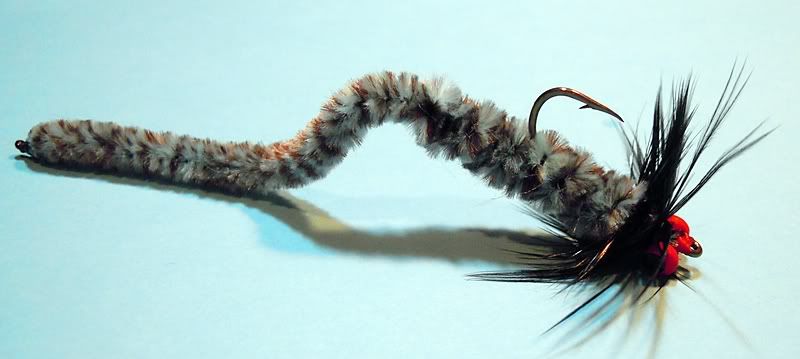Dave,
I’m primarily a bass fisherman. I started with conventional gear, fished tournaments for many years, and only in the last twenty years discovered the long rod.
As fly tyers, we really get hung up on a how fly ‘looks’. Probably the trout fishing roots and all that ‘match the hatch’ stuff. There is something about how a soft plastic worms moves in the water that makes it so efffective. It’s a combination of mass, stiffness to softness ratios, water displacement, and a few other intangibles that make it the number one bass lure ever created.
While we can tie a fly to look like a plastic worm, our efforts seldom work as effectively. Primarily because our restrictions on weight and materials used mean that the fly doesn’t move like the worm.
We can get close, though, but flies tied to look like worms haven’t proven to be an effective substitute for me. What I always wanted was a fly that ‘caught the same fish’. I’ve tied and fished several dozen versions of such flies, and all have been disapointing at best.
My search finally lead me to examining the way the worm moves in the water, and then trying to get a fly that ‘duplicates’ that movement. Mainstream bass anglers fish soft plastics rigged many different ways, so several different ties were required to match the methods used.
The easiest one for me to match was the standard ‘texas rigged’ worm. With a bullet weight of modest weight this bait lifts and glides as it falls on the standard ‘lift the rod, let it fall, take up the slack’ retrieve. Most, if not all, of the strikes on this rig come as the worm glides back to the bottom. To get the same action, and the same fish, a Clouser minnow fished in the same way will work as well, often better. It’s restricted to shallower waters, maybe down to ten feet, floating line and long leader. You have to use the rod lift/drop retrieve, though, or it won’t work. As with the real soft plastic worm, strikes come on the fall.
The carolina rig, with it’s heavy weight bottom hugging glide required a different approach. Full sinking line, unweighted fly. For this, I use a Semi-Seal leech. Size 2 to 6, 4x long, no weight. This fly is slim in the water and it’s by far my most effective bass technique.
For matching the weightless plastic worm with it’s glide and slow fall, I use a floating line, long heavy mono tippet, and a bead head leech. The heavy tippet keeps it falling slowly and prevents the bead from dragging it head first.
We are at an advantage with the suspended soft plastic techniques like the shaky head or swimming worm simply because we can better control the depth. The standard ‘strip-strip-strip’ retrieve matches the up and down pattern of these techniques perfectly, and with the appropriate type of line we can outfish most conventional anglers with a lightly weighted clouser.
I’m still working on the vertical presentation shallow water/target fishing presentation. Bass take these baits on a slack line as they fall, and the soft plastic makes them hold on until you figure out you’ve been bit and can set the hook. Most flies aren’t that lifelike in feel, and a bass can expell a fly pretty quickly. I have a weighted spun deer hair and rabbit strip fly that seems promising, but I’ve not fished it enough to be confident of it yet.
As far as depth goes, I can use a fast sinking line and a leech effectively down to about 20 feet. I just don’t fly fish any deeper than that.
The only time a fly tied to look like a worm worked well for me was in a seldom fished farm pond in Alabama. I think the fish there would have eaten anything.
Good Luck!
Buddy





